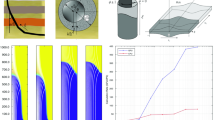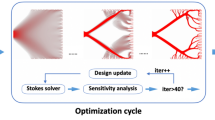Abstract
Automatic analysis of large-scale 3D flow field promotes the combination of topological analysis and integration curve analysis methods. Critical point detection and location are one of the key core algorithms of topological analysis. Dealing with large-scale flow fields in parallel, eliminating memory constraints, and obtaining high-precision position of critical points robustly are still primary challenges. Therefore, a novel parallel detection and location method on the GPU is proposed and denoted by HybridDualCP. It uses the duality property of the cartesian coordinate system and the velocity vector space inside each grid cell. It achieves high locality, has the ability of large-scale parallelization, and can quickly detect and locate critical points in large-scale 3D flow fields. Furthermore, based on the Inverse Distance Weighting (IDW) interpolation algorithm in the dual space, it eliminates the computation of solving systems of high-order or linear equations and can support any dimensional simplex mesh type. HybridDualCP provides the position classification of critical points relative to the grid cell by explicitly considering the inside/facet/edge/vertex. By detecting critical points in 29 typical 3D flow fields, HybridDualCP is faster, more robust and comprehensive than currently widely used methods. This paper also shows the effect of streamline visualization guided by critical points and the necessity of distinguishing critical points at different locations relative to the grid cell.






Similar content being viewed by others
References
Aumüller M, Bernhardsson E, Faithfull A (2020) Ann-benchmarks: a benchmarking tool for approximate nearest neighbor algorithms. Inf Syst 87:101374
Ba Z, Shan G, Liu J (2016) A feature-based seeding method for multi-level flow visualization. J Comput Aid Desig Comput Graph 28:32–40
Bhatia H, Gyulassy A, Wang H, Bremer PT, Pascucci V (2014) Robust detection of singularities in vector fields. In: Topological methods in data analysis and visualization III. Springer, New York
Bi C, Yang L, Duan Y, Shi Y (2019) A survey on visualization of tensor field. J Visualization 22(3):641–660
Cary AW, Chawner J, Duque EP, Gropp W, Kleb WL, Kolonay RM, Nielsen E, Smith B (2021) Cfd vision 2030 road map: Progress and perspectives. In: AIAA AVIATION 2021 FORUM, p 2726
Chen G, Mischaikow K, Laramee RS, Pilarczyk P, Zhang E (2007) Vector field editing and periodic orbit extraction using morse decomposition. IEEE Trans Visual Comput Graphics 13(4):769–785
Chen G, Mischaikow K, Laramee RS, Zhang E (2008) Efficient morse decompositions of vector fields. IEEE Trans Visual Comput Graphics 14(4):848–862
Debenedetti PG, Sciortino F, Zerze GH (2020) Second critical point in two realistic models of water. Science 369(6501):289–292
Edelsbrunner H, Mücke EP (1990) Simulation of simplicity: a technique to cope with degenerate cases in geometric algorithms. ACM Transn Graphics (tog) 9(1):66–104
Garth C, Tricoche X, Scheuermann G (2004) Tracking of vector field singularities in unstructured 3d time-dependent datasets. In: IEEE Visualization 2004. IEEE, pp 329–336
Guo H, Lenz D, Xu J, Liang X, He W, Grindeanu IR, Shen HW, Peterka T, Munson T, Foster I (2021) Ftk: a simplicial spacetime meshing framework for robust and scalable feature tracking. IEEE Trans Visual Comput Graphics 27(8):3463–3480
Helman J, Hesselink L (1989) Automated analysis of fluid flow topology. Three-dimensional visualization and display technologies, vol 1083. International society for optics and photonics, pp 144–152
Kumar V, Mukherjee R (2021) Study of separation of three-dimensional boundary layer using critical point theory. In: AIAA Scitech 2021 Forum, p 1995
Lavin Y, Batra R, Hesselink L (1998) Feature comparisons of vector fields using earth mover’s distance. In: Proceedings Visualization’98 (Cat. No. 98CB36276). IEEE, pp 103–109
Li WC, Vallet B, Ray N, Levy B (2006) Representing higher-order singularities in vector fields on piecewise linear surfaces. IEEE Trans Visual Comput Graphics 12(5):1315–1322
Liang X, Guo H, Di S, Cappello F, Raj M, Liu C, Ono K, Chen Z, Peterka T (2020) Toward feature-preserving 2d and 3d vector field compression. In: PacificVis, pp 81–90
Malik MR (2015) Cfd vision 2030 cfd study: A pathway to revolutionary computational aerosciences. In: High-performance computing (HPC) user forum, NF1676L-21143
Min J, Jing R, Liguo Z (2021) Research on extraction algorithm of critical points of ocean flow field for topological analysis. Haiyang Xuebao 43(5):135–144
Montani C, Scateni R, Scopigno R (1994) Discretized marching cubes. Proceedings Visualization’94. IEEE, pp 281–287
Polthier K, Preuß E (2003) Identifying vector field singularities using a discrete hodge decomposition. Springer, pp 113–134
Reininghaus J, Hotz I (2011) Combinatorial 2d vector field topology extraction and simplification. Topological methods in data analysis and visualization. Springer, pp 103–114
Reininghaus J, Lowen C, Hotz I (2010) Fast combinatorial vector field topology. IEEE Trans Visual Comput Graphics 17(10):1433–1443
Rojo IB, Günther T (2019) Vector field topology of time-dependent flows in a steady reference frame. IEEE Trans Visual Comput Graphics 26(1):280–290
Sane S, Bujack R, Garth C, Childs H (2020) A survey of seed placement and streamline selection techniques. STAR 39(3):789
Shewchuk JR (1997) Adaptive precision floating-point arithmetic and fast robust geometric predicates. Discrete Comput Geom 18(3):305–363
Skala V, Smolik M (2018) A new approach to vector field interpolation, classification and robust critical points detection using radial basis functions. In: Computer Science On-line Conference. Springer, pp 109–115
Skraba P, Rosen P, Wang B, Chen G, Bhatia H, Pascucci V (2016) Critical point cancellation in 3d vector fields: robustness and discussion. IEEE Trans Visual Comput Graphics 22(6):1683–1693
Smolik M, Skala V (2019) Efficient simple large scattered 3d vector fields radial basis functions approximation using space subdivision. In: International Conference on Computational Science and its Applications. Springer, pp 337–350
Tricoche X, Garth C, Sanderson A (2011) Visualization of topological structures in area-preserving maps. IEEE Trans Visual Comput Graphics 17(12):1765–1774
Tricoche X, Garth C, Sanderson A, Joy K (2012) Visualizing invariant manifolds in area-preserving maps. In: Topological methods in data analysis and visualization II. Springer, pp 109–124
Wang W, Wang W, Li S (2018) Detection and classification of critical points in piecewise linear vector fields. J Visualization 21(1):147–161
Ye X, Kao D, Pang A (2005) Strategy for seeding 3d streamlines. In: VIS 05. IEEE Visualization, 2005. IEEE, pp 471–478.
Zhengquan L, Yaoxiang W (2015) Inverse distance weighted interpolation involving position shading. Acta Geodaetica et Cartographica Sinica 44(1):91
Acknowledgements
We thank Bhatia Harsh for his patient help by email communication. We appreciate the anonymous reviewers for their comments and suggestions on the paper. This work was supported by the National Science Foundation of China (91752111).
Author information
Authors and Affiliations
Corresponding author
Additional information
Publisher's Note
Springer Nature remains neutral with regard to jurisdictional claims in published maps and institutional affiliations.
Rights and permissions
About this article
Cite this article
Huang, ZB., Fu, GT., Cao, Lj. et al. A parallel high-precision critical point detection and location for large-scale 3D flow field on the GPU. J Supercomput 78, 9642–9667 (2022). https://doi.org/10.1007/s11227-021-04220-6
Accepted:
Published:
Issue Date:
DOI: https://doi.org/10.1007/s11227-021-04220-6




